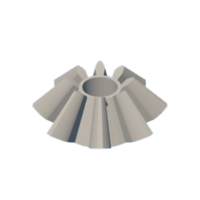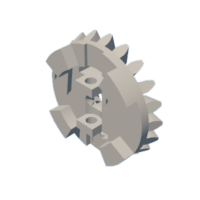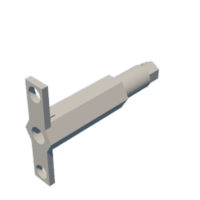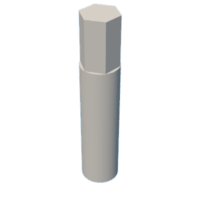Introduction: Locking Differential
I have been working on a 3D printed RC 1/10 model 4wd on and off for about a year now. This is my locking differential so far. Too be honest, the locking aspect of the differential is not currently functional, but the rest of the differential is functioning. I am still working on the differential and will update this Instructable as I revise this design. I guess right now, this Instructable is more for inspiration.
Supplies
Filament and access to a 3D printer
- have used PLA+ to print all the parts so far and have had no issues. However, I have not tested it on a full model with much more weight. Nylon is a common alternative for the bevel gears, but I think PLA would still be suitable for the casing. Keep in mind that to print nylon a printer with an enclosure is highly recommended.
- 2x M3 nuts
- M4 threaded rod (length really depends on how long you want each axle to be)
- 3mm rod - about 25mm
- 7 6x10x3 (MR106) bearings - sorry these probably aren't the most common bearings, but it was what I had on hand when I started designing it
- 6mm M3 grub screws
Step 1: Explaining the Design
A differential is used in vehicles to allow the outside wheels to rotate faster than the inside wheels on a corner as they have a larger distance to travel. However, when off roading, this can cause problems since the differential sends power to the wheel with the least amount of friction, i.e. which requires the least amount of force to move. For example, if one wheel on an axle is in the air or on slippery mud, it will receive all of the power and spin the wheels, hence not providing any drive or forward momentum. Meanwhile, the other wheel, which may have enough friction to move the vehicle will remain without any power.
A locking differential forces power to be split 50/50 between both wheels on an axle, and is a common feature on 4wds actually designed to go off road.
There are many ways 4wds can lock the differential. I believe that the majority have a system which locks gears within the main differential centre. However, due to the size constraints, this was too hard. Hence, I designed a system which moves a locker to lock the main differential gear to one of the axles to lock the differential.
The main difficulty I had in designing this differential was to design a way to move a locker in linear motion without taking up much space or weight on the axle as you generally want to reduce the amount of unsprung weight (range of motion required shown above) Hence, this kind of prohibited using a servo. My final idea was to use springs to have a "default state" of locked, what a string then being pulled to unlock the differential and move the locker to the right. This way, the servo can be mounted on the body.
The other problem I faced was designing small bevel gears which meshed properly. I have been using the GF Gear Generator to do this until now. However, I followed a tutorial (Drawing Bevel Gear for 3D printing in Fusion 360 - quick version - really recommend this to make bevel gears yourself) to design the bevel gears myself, and this worked much better. I have an Ender 3 V2, and I my current module is 1.5. I do think I can get smaller than this, but those who have more high quality printers can probably easily get much smaller.
Step 2: Printing Out the Parts
As I stated in the introduction, I honestly wouldn't recommend building the differential in its current state as the locking function doesn't work. However, I'm still going to provide the STLs and the Fusion 360 file so that people can use it for inspiration or even modify and make it work.
I also am still working on this project, so I will update this Instructable as I further develop the differential.
None of the parts except the "MainGear" need supports.
Also, the "Locker" requires you to pause the print to insert M3 nuts. I have made the tolerances for this quite large, so you shouldn't have too many problems with this. Some people recommend to put masking tape on top of the nut, but I have never had any issues without tape (https://www.youtube.com/watch?v=MWKmggM3iAU decent tutorial for pausing at height"
Attachments
Step 3: Putting It Together
Next you'll have to put it together. There are behind both gears on the sides of the centre. You will also have to cut to size a 3mm rod. I just hot-glued it into place. The whole design uses M4 rods as the axles. Therefore, the "bearig section", "BackSideAxle" and "FrontSideAxle" will have to be screwed on to an M4 rod. I would also use some threadlock. Without the locker, and springs the differential should work quite smoothly.
The image shows roughly how the final produce should work. However, my original plan of using string wrapped around the thin notch to move the left and right didn't work, so I will have to design another mechanism to go in that notch.
Step 4: Conclusion
This definitely isn't going to be the best Instructable out there, but I just thought to put it out as I am sure someone will be able to benefit. If this project is something you would like to make, I wouldn't now, but in about a month I hope that I will have to fully working. Then, I will update this Instructable and properly explain how to put it together.


























